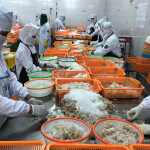Melony Sellars is the CEO and managing director of Genics, a provider of shrimp health and pathogen management technology based in Saint Lucia, Queensland, Australia. Sellars has 20 years of experience in aquaculture, with an in-depth background in shrimp aquaculture, including extensive expertise in the application of novel biotech solutions for industry, genetics, and breeding programs.
In 2019, Australia’s Commonwealth Scientific and Industrial Research Organization (CSIRO) undertook a scientific investigation into the effectiveness of shrimp point-of-care (POC) test kits in detecting white spot syndrome virus (WSSV) for possible use in disease management.
At the time of the study, POC tests had become a go-to method of disease detection for farmers – a situation that persists to this day. However, with the CSIRO’s recent presentation of its findings at Australia’s National Shrimp Farmers conference – the 2023 ProAqua Symposium – it’s time for a global, urgent reassessment of testing practices.
WSSV continues to persist as one of the global shrimp industry’s most economically impactful pathogens. In 2016, severe outbreaks of WSSV in Queensland, Australia, snapped the virus to the forefront of the national shrimp industry’s attention. With WSSV emergency response measures destroying farm populations and costing producers millions of dollars, farmers urgently needed a way to monitor their animals for early-stage WSSV infection.
Global uptake of POC test kits, including for WSSV, had become second nature in the shrimp industry, being used for various purposes, including early-stage WSSV detection. With WSSV devastation at its doorstep in 2016, the Australian shrimp industry requested access to such kits, which first required government approval.
In 2019, at the request of a battered shrimp industry, the CSIRO commenced a laboratory-based evaluation of WSSV tests to determine the efficacy and fitness for purpose of POC test kits compared to laboratory PCR testing.
That year, CSIRO collaborated with shrimp industry stakeholders on a comprehensive study of WSSV testing methods. The study report, titled “Evaluation of POC tests for White Spot Syndrome Virus,” compares commercially available tests designed to detect WSSV on commercial shrimp farms with laboratory-run PCR WSSV tests.
CSIRO’s research compares and assesses five WSSV tests, comprising three rapid antigen-style tests and two PCR-based tests. After exhaustive testing, the study clearly shows that rapid antigen POC test kits yield inferior limits of detection when compared with PCR laboratory testing. The research group found that rapid antigen-style POC tests were a suboptimal defense against WSSV because “POC tests had lower sensitivity than validated laboratory reference WSSV qPCR tests.”
The lack of sensitivity typically involved with rapid antigen POC testing is such that it actually creates a false sense of security for farmers. The CSIRO study’s findings are crucially significant for the global industry because the current expectation among farmers is that POC tests can detect WSSV in the early stages of infection, providing early warning signs of disease.
However, CSIRO’s study emphasizes that POC tests are not, in fact, a solution for WSSV early warning and prevention.
Among the several problems with POC kits, CSIRO emphasizes the gap between user expectations and actual test kit sensitivity in the field.
Farmer confidence in POC test kits is supported by the perception that they can detect WSSV early enough to prevent large-scale stock losses, but CSIRO’s research reveals that the studies used to prove POC kit capability were conducted in laboratory conditions, where the infection speed and transmission pathways did not reflect the reality on farms. Careful reading of manufacturers’ guidelines on some kits also reveals that validation occurs on synthetic templates, providing unrealistic guidelines for real-world use on shrimp samples.
The CSIRO research team writes in the report that “in existing literature, all POC tests were reported to be able to detect WSSV in the early stages of infection.”
“[However,] the live prawn experiments conducted in this study demonstrate that white spot disease progresses much faster when prawns are injected with WSSV compared to when they are cohabitated with WSSV-infected cohorts,” the study said. “Thus, the predicted time frame from WSSV exposure to WSSV detection by POC testing in the field may be overestimated.”
This finding underlines the crucial problem with POC tests as a means of WSSV control. The virus develops more rapidly in shrimp that are deliberately infected for the purposes of POC kit test validation. However, when used in commercial settings, where disease develops more slowly in individual animals, POC test kits fail to find the virus early enough to prevent infection from spreading throughout farm populations. This fatal flaw in POC kit sensitivity means that if farmers continue to use them for WSSV detection, they will miss the virus in its early stages, leading to continued disease outbreaks.
WSSV is now endemic worldwide, so vigilant preventive monitoring with fit-for-purpose testing technology is essential. WSSV can destroy entire shrimp farm populations in mere days, underlining the need for an effective early detection regime.
As for validated, laboratory-based PCR testing, the study highlighted that these tests can be 100-fold more sensitive than one of the most commonly used POC test kits on the market.
“For weak positive samples – typical of early-stage WSSV infection – sensitivity of POC tests is inadequate, with only 56 percent to 78 percent of replicate weak positive samples testing positive, in contrast to the 100 percent concordance demonstrated by the laboratory reference qPCRs,” the study found.
For farmers, the conclusion to be drawn from CSIRO’s research is emphatically clear: To avoid destructive outbreaks of WSSV, the shrimp industry urgently needs to pivot toward using lab-based PCR tests for routine testing instead of relying on rapid antigen POC kits. Notably, such lab-based PCR tests must also be properly validated by laboratory personnel, with all assays varying in performance based on equipment, chemistry, people, and operating conditions.
With turnaround times on laboratory testing as short as 24 hours, any concerns about immediacy can be set aside. Performing an on-site POC test gives the false security of quick results, but the reality is that due to their lack of sensitivity, POC tests miss disease in its early stages when a lab test would detect it.
It should also be noted that lab-based PCR tests must be properly validated in any given laboratory to ensure optimal performance and that validation is an ongoing requirement – not a one-off event.
The early warning aspect of lab-based PCR testing delivers a vital advantage to farmers since knowing about WSSV infection on their farm a few days early can prevent catastrophic stock losses.
When disease outbreaks can decimate shrimp farms in mere days and millions of dollars are on the line, CSIRO’s research sends a strong signal to the shrimp industry to stop relying on POC kits. Lab-based PCR testing, with its superior sensitivity and reliability, is the only way to effectively manage the threat of WSSV.
Photo courtesy of CSIRO






